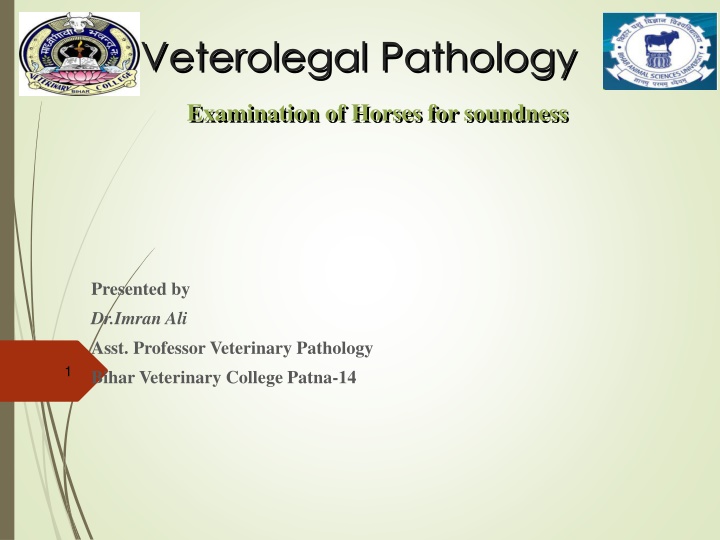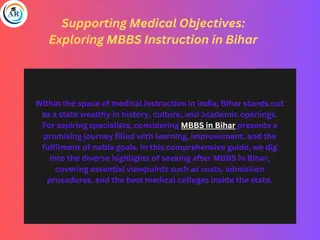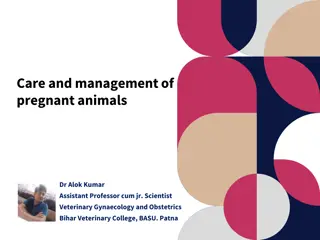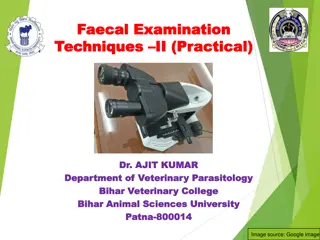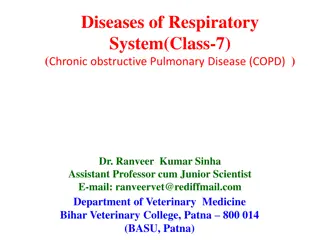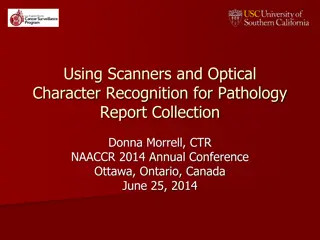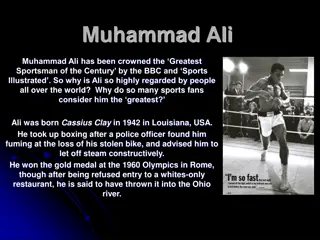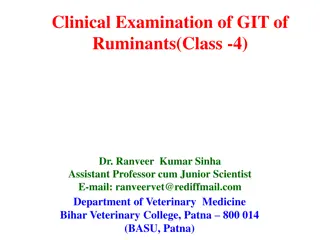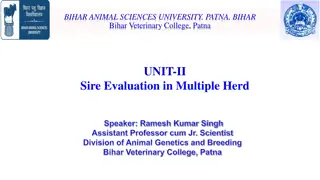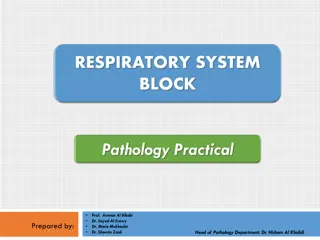Veterolegal Pathology: Examination of Horses for Soundness by Dr. Imran Ali, Asst. Professor at Bihar Veterinary College
In the field of veterolegal pathology, examining horses for soundness is crucial for assessing their natural usefulness. This examination involves identifying conditions such as bone spavin, bog spavin, bowed tendon, and curb, each with specific symptoms that indicate unsoundness as per legal definitions. Understanding these signs is essential for proper evaluation and decision-making in horse sales and care.
Download Presentation

Please find below an Image/Link to download the presentation.
The content on the website is provided AS IS for your information and personal use only. It may not be sold, licensed, or shared on other websites without obtaining consent from the author.If you encounter any issues during the download, it is possible that the publisher has removed the file from their server.
You are allowed to download the files provided on this website for personal or commercial use, subject to the condition that they are used lawfully. All files are the property of their respective owners.
The content on the website is provided AS IS for your information and personal use only. It may not be sold, licensed, or shared on other websites without obtaining consent from the author.
E N D
Presentation Transcript
Veterolegal Pathology Examination of Horses for soundness Presented by Dr.Imran Ali Asst. Professor Veterinary Pathology Bihar Veterinary College Patna-14 1
EXAMINATION OF HORSES FOR SOUNDNESS The legal definition of soundness is based on the judgment of Baron Park (1842), who declared: The rule to soundness is that if at the time of sale the horse has any disease which actually does diminish the natural usefulness of the animal Horse has either from disease or accident undergone any alteration of structure that either actually does at the time or in its ordinary effects will diminish the natural usefulness of the horse, such a horse is unsound
Bone spavin: Is a periostitis or ostitis of the medial aspect of the proximal end of the third metatarsal bone and the medial aspect of the third central tarsal bones. Symptoms 1. An enlargement on the inner aspect of the hock. 2. Pain during flexion of the hock joint. 3. Reduction in the height of the foot. 4. The foot lands on the toe. 5. The toe becomes too short and the heel too high.
Bog spavin: A chronic distension of the joint capsule of the hock. Symptoms 1. Three characteristic fluctuating swellings, the largest of which is located at anterio-medical aspect of the hock joint. 2. Two smaller swellings occur on either side of the posterior surface of the hock joint at the junction of the tibial tarsal and fibular tarsal bones. 3. Pressure on any one of these swellings will show an increase in the size of other swellings.
Bowed tendon: Is an inflammation of deep and/or superficial flexor tendons and their associated tendon sheath. Symptoms. 1. Hot, painful and diffused swelling over the involved area. 2. Horse will stand with the heel elevated. 3. The carpus usually will be pushed forward while the horse is at rest. 4. In chronic cases there will be fibrosis in the area of the original injury. 5. Dropping of the fetlock.
Curb: An enlargement at the posterior aspect of the fibular tarsal bone. Symptoms 1. Hot swelling can be palpated in the area. 2. The horse will stand with the heel elevated. 3. In chronic cases, the area becomes infiltrated with scar tissue and a permanent blemish results. 4. The corium shows a chronic vegetative growth.
Corn: Is an involvement of sensitive and insensitive tissues of the sole at the angle formed by the wall and the bar. Symptoms 1. Haemorrhage on the inner surface of the corm (Dry Corn) 2. Serum beneath the injured corn (Moist Corn). 3. Necrosis of the sensitive laminae (Suppurating Corn.)
Capped elbow: Bursitis of the elbow joint. Symptoms 1. Swelling over the point of the elbow. 2. Fluid or fibrous tissue in the swelling.
Capped Hock: Bursitis of the hock joint. Symptoms 1. Firm swelling at the joint of the hock. 2. Associated with curb.
Cataract: Opacity of the eye lens. Symptoms 1. Pearly white opacity. 2. Opacity varies in size from an almost imperceptible spot to an opacity covering the entire anterior surface of the lens.
Cryptorchldlsm: A condition in which one or both testes fail to descend into the scrotum. Symptoms 1. Testicles are absent form the scrotum. 2. Animal may show a greater sexual desire.
Dropped sole: The sole is dropped to or beyond the level of the bearing surfae of the hoof wall. Symptoms 1. Flat sole and has no concavity. 2. Heavy rings in the hoof wall. 3. Sole becomes very thick and composed of flakes. 4. Pink coloured sole under these flakes.
Heaves: A respiratory disorder of horses characterised by a double expiratory effort. Symptoms 1. Prolongation and exaggeration of the expiratory phase. 2. Animal develops dyspnoea during moderate exercise. 3. Persistent short weak cough and a nasal discharge. 4. Auscultation reveals vesicular sounds which may be displaced by dry or moist rales.
Hernia: Is the protrusion of a portion of the abdominal contents through an opening in the abdominal wall. Umbilical and scrotal hernias are considered to be unsound conditions. Symptoms 1. Internal inguinal ring will be enlarged in scrotal hernia. This can be palpated by rectal examination. 2. For umbilical hernia, the naval should be palpated.
Knee sprung: An anterior deviation of the carpus. Symptoms 1. The carpal joint will be flexed forward. 2. Shortening of the anterior phase of the stride.
Laminitis: is an inflammation of the laminae of the foot. Symptoms 1. 1. 2. 3. 4. 2. 1. 2. 3. 4. Acute Horse tends to lie down. Hot sole, wall and coronary band. Increased digital pulse. Uniform tenderness over the entire area of the sole Chronic Rotation of the third phalanx. Separation of the sensitive and insensitive laminae. Tendency to land on the heel. The Sole is dropped and flat.
Navicular disease: An inflammation of navicular bursa. Symptoms 1. Intermittent lameness. 2. Horse stands with both feet too far. 3. Horse tends to land on the toe of the foot during movement. 4. Foot becomes smaller due to contraction.
Over-reaching: a form of limb interference. Symptoms 1. The toe of the hind foot catches the heel of the fore foot on the same side. 2. Shoe pulling.
